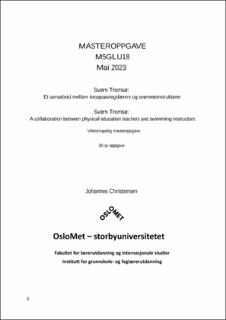| dc.description.abstract | I 2017 lanserte regjeringen «Svømmepakken», bestående av seks tiltak for å bedre svømmeopplæringen i grunnskolen. Et av de seks tiltakene var å gi støtte til samarbeid mellom skoler/kommuner og frivillige organisasjoner som arbeider med svømming. På bakgrunn av dette tiltaket har Tromsø kommune startet et prosjekt ved navn Svøm Tromsø for å standardisere svømmeopplæringen for alle grunnskoleelevene i hele kommunen. Svømmeopplæringen har siden foregått i et samarbeid hvor kroppsøvingslærere får bistand fra svømmeinstruktører med svømmefaglig kompetanse. Problemstillingen for denne oppgaven er derfor: Hvordan opplever kroppsøvingslærere at samarbeidet med Svøm Tromsø påvirker kvaliteten av svømme- og livredningsopplæringen? Det teoretiske grunnlaget for denne oppgaven er Engeströms bidrag til kulturhistorisk aktivitetsteori. Oppgaven har en kvalitativ tilnærming, hvor semistrukturerte intervju ble brukt i datainnsamlingen for å svare på problemstillingen. Utvalget av informanter besto av tre ulike kroppsøvingslærere fra tre ulike ungdomsskoler i kommunen. Resultatene viser en variasjon i lærernes svømmefaglige kompetanse, og instruktørenes pedagogiske kompetanse. Rammefaktorer som store elevgrupper, korte undervisningsøkter og få undervisningstimer var utfordrende i svømmeundervisningen. To av informantene påpeker at det nå er flere elever på kanten i svømmeundervisningen sammenliknet med før Svøm Tromsø. Lærerne er har undervisningsansvaret, mens instruktørene bistår. Instruktørene er ansvarlig for valg av innhold. Det medfører et undervisningsopplegg som er preget av utvikling av svømmetekniske ferdigheter, og lite lek. Kun en av de åtte undervinsingsøktene er tillagt livredningsopplæring. Svøm Tromsø tilbyr ikke utendørs livredningsopplæring i henhold til kompetansemål for ungdomstrinn, dermed må skolene gjennomføre det på eget initiativ. Svøm Tromsøs svømmeopplæring bidrar til en likere undervisning for alle elevene i kommunen, dermed blir kvaliteten gjennomsnittlig høyere, men noen skoler har nå mindre svømmeopplæring enn før.
In 2017 the Norwegian government launched “Svømmepakken”, consisting of six measures to improve swimming education in schools. One of the six measures was to provide support for collaboration between schools/municipalities and voluntary organizations working with swimming. Based on this initiative, Tromsø initiated a project called “Svøm Tromsø” to standardize swimming education for all primary school students in the entire municipality. Since then, swimming education has been collaborative project where physical education (PE) teachers receive assistance from swimming instructors with swimming expertise. Therefore, the research question for this thesis is: How do PE teachers experience that the collaboration with Svøm Tromsø affects the quality of swimming and lifesaving education? The theoretical framework for this thesis is Engeströms contribution to cultural-historical activity theory. This study employs a qualitative approach, where semi structured interviews were used for data collection to address the research question. The total amount of informants consisted of three different PE teachers from three different secondary schools. The results revealed a variation in the teacher’s swimming expertise and the swimming instructors’ pedagogical competence. Factors as large student groups, short lessons, and limited lessons posed as challenging for the swimming education. Two of the informants noted that there are now more students poolside during the lessons compared to before Svøm Tromsø. The teachers have the teaching responsibilities, while the instructors provide assistance. The instructors are responsible for selecting the content, resulting in a teaching approach focused on technical swimming skills and limited playfulness. Only one of the eight teaching lessons is dedicated to lifesaving education. Svøm Tromsø does not offer outdoor life saving education in accordance with the competency goals for secondary school, the schools must implement it on their own initiative. Svøm Tromsø’s swimming education provides a more standardized swimming education for all student in the municipality, resulting in an overall higher quality. However some schools now have less swimming education compared to before. | en_US |
